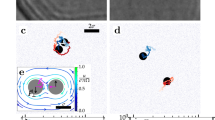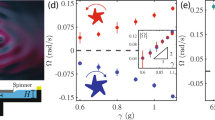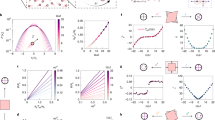Abstract
In simple fluids, such as water, invariance under parity and time-reversal symmetry imposes that the rotation of constituent ‘atoms’ is determined by the flow and that viscous stresses damp motion. Activation of the rotational degrees of freedom of a fluid by spinning its atomic building blocks breaks these constraints and has thus been the subject of fundamental theoretical interest across classical and quantum fluids. However, the creation of a model liquid that isolates chiral hydrodynamic phenomena has remained experimentally elusive. Here, we report the creation of a cohesive two-dimensional chiral liquid consisting of millions of spinning colloidal magnets and study its flows. We find that dissipative viscous ‘edge-pumping’ is a key and general mechanism of chiral hydrodynamics, driving unidirectional surface waves and instabilities, with no counterpart in conventional fluids. Spectral measurements of the chiral surface dynamics suggest the presence of Hall viscosity, an experimentally elusive property of chiral fluids. Precise measurements and comparison with theory demonstrate excellent agreement with a minimal chiral hydrodynamic model, paving the way for the exploration of chiral hydrodynamics in experiment.
This is a preview of subscription content, access via your institution
Access options
Access Nature and 54 other Nature Portfolio journals
Get Nature+, our best-value online-access subscription
$29.99 / 30 days
cancel any time
Subscribe to this journal
Receive 12 print issues and online access
$209.00 per year
only $17.42 per issue
Buy this article
- Purchase on Springer Link
- Instant access to full article PDF
Prices may be subject to local taxes which are calculated during checkout





Similar content being viewed by others
Data availability
The data that support the plots within this paper and other findings of this study are available from the corresponding author upon request.
References
Bandurin, D. A. et al. Negative local resistance caused by viscous electron backflow in graphene. Science 351, 1055–1058 (2016).
Pringle, J. E. & King, A. Astrophysical Flows (Cambridge University Press, 2007).
Secchi, E. et al. Massive radius-dependent flow slippage in carbon nanotubes. Nature 537, 210–213 (2016).
van Zuiden, B. C., Paulose, J., Irvine, W. T. M., Bartolo, D. & Vitelli, V. Spatiotemporal order and emergent edge currents in active spinner materials. Proc. Natl Acad. Sci. USA 113, 12919–12924 (2016).
Lenz, P., Joanny, J.-F., Jülicher, F. & Prost, J. Membranes with rotating motors. Phys. Rev. Lett. 91, 108104 (2003).
Fürthauer, S., Strempel, M., Grill, S. W. & Jülicher, F. Active chiral processes in thin films. Phys. Rev. Lett. 110, 048103 (2013).
Kokot, G. et al. Active turbulence in a gas of self-assembled spinners. Proc. Natl Acad. Sci. USA 114, 12870–12875 (2017).
Yeo, K. & Maxey, M. R. Rheology and ordering transitions of non-Brownian suspensions in a confined shear flow: effects of external torques. Phys. Rev. E 81, 062501 (2010).
Nguyen, N. H., Klotsa, D., Engel, M. & Glotzer, S. C. Emergent collective phenomena in a mixture of hard shapes through active rotation. Phys. Rev. Lett. 112, 075701 (2014).
Ariman, T., Turk, M. A. & Sylvester, N. D. Microcontinuum fluid mechanics—a review. Int. J. Eng. Sci. 11, 905–930 (1973).
Scaffidi, T., Nandi, N., Schmidt, B., Mackenzie, A. P. & Moore, J. E. Hydrodynamic electron flow and Hall viscosity. Phys. Rev. Lett. 118, 226601 (2017).
Wiegmann, P. & Abanov, A. G. Anomalous hydrodynamics of two-dimensional vortex fluids. Phys. Rev. Lett. 113, 034501 (2014).
Banerjee, D., Souslov, A., Abanov, A. G. & Vitelli, V. Odd viscosity in chiral active fluids. Nat. Commun. 8, 1573 (2017).
Avron, J. E., Seiler, R. & Zograf, P. G. Viscosity of quantum Hall fluids. Phys. Rev. Lett. 75, 697–700 (1995).
Avron, J. E. Odd viscosity. J. Stat. Phys. 92, 543–557 (1998).
Abanov, A., Can, T. & Ganeshan, S. Odd surface waves in two-dimensional incompressible fluids. SciPost Phys. 5, 010 (2018).
Knaap, H. & Beenakker, J. Heat conductivity and viscosity of a gas of non-spherical molecules in a magnetic field. Physica 33, 643–670 (1967).
Hulsman, H. & Knaap, H. Experimental arrangements for measuring the five independent shear-viscosity coefficients in a polyatomic gas in a magnetic field. Physica 50, 565–572 (1970).
Petroff, A. P., Wu, X.-L. & Libchaber, A. Fast-moving bacteria self-organize into active two-dimensional crystals of rotating cells. Phys. Rev. Lett. 114, 158102 (2015).
Belovs, M. & Cēbers, A. Hydrodynamics with spin in bacterial suspensions. Phys. Rev. E 93, 062404 (2016).
Grzybowski, B. A., Stone, H. A. & Whitesides, G. M. Dynamic self-assembly of magnetized, millimetre-sized objects rotating at a liquid–air interface. Nature 405, 1033–1036 (2000).
Grzybowski, B. A., Jiang, X., Stone, H. A. & Whitesides, G. M. Dynamic, self-assembled aggregates of magnetized, millimeter-sized objects rotating at the liquid–air interface: Macroscopic, two-dimensional classical artificial atoms and molecules. Phys. Rev. E 64, 011603 (2001).
Grzybowski, B. A., Stone, H. A. & Whitesides, G. M. Dynamics of self assembly of magnetized disks rotating at the liquid-air interface. Proc. Natl Acad. Sci. USA 99, 4147–4151 (2002).
Grzybowski, B. A. & Whitesides, G. M. Dynamic aggregation of chiral spinners. Science 296, 718–721 (2002).
Yan, J., Bae, S. C. & Granick, S. Rotating crystals of magnetic Janus colloids. Soft Matter 11, 147–153 (2014).
Yan, J., Bae, S. C. & Granick, S. Colloidal superstructures programmed into magnetic Janus particles. Adv. Mater. 27, 874–879 (2015).
Rosensweig, R. E. Ferrohydrodynamics (Courier Corporation, 2013).
Torres-Daz, I. & Rinaldi, C. Recent progress in ferrofluids research: novel applications of magnetically controllable and tunable fluids. Soft Matter 10, 8584–8602 (2014).
Tsai, J.-C., Ye, F., Rodriguez, J., Gollub, J. P. & Lubensky, T. C. A chiral granular gas. Phys. Rev. Lett. 94, 214301 (2005).
Scholz, C., Engel, M. & Pöschel, T. Rotating robots move collectively and self-organize. Nat. Commun. 9, 931 (2018).
Bacri, J.-C., Perzynski, R., Shliomis, M. I. & Burde, G. I. ‘Negative-viscosity’ effect in a magnetic fluid. Phys. Rev. Lett. 75, 2128–2131 (1995).
Climent, E., Yeo, K., Maxey, M. R. & Karniadakis, G. E. Dynamic self-assembly of spinning particles. J. Fluids Eng. 129, 379–387 (2006).
Goto, Y. & Tanaka, H. Purely hydrodynamic ordering of rotating disks at a finite Reynolds number. Nat. Commun. 6, 5994 (2015).
Yeo, K., Lushi, E. & Vlahovska, P. M. Collective dynamics in a binary mixture of hydrodynamically coupled microrotors. Phys. Rev. Lett. 114, 188301 (2015).
Snezhko, A. Complex collective dynamics of active torque-driven colloids at interfaces. Curr. Opin. Colloid Interface Sci. 21, 65–75 (2016).
Bacri, J.-C., Cebers, A. O. & Perzynski, R. Behavior of a magnetic fluid microdrop in a rotating magnetic field. Phys. Rev. Lett. 72, 2705–2708 (1994).
Bonthuis, D. J., Horinek, D., Bocquet, L. & Netz, R. R. Electrohydraulic power conversion in planar nanochannels. Phys. Rev. Lett. 103, 144503 (2009).
Dahler, J. S. & Scriven, L. E. Theory of structured continua. I. General consideration of angular momentum and polarization. Proc. R. Soc. Lond. A 275, 504–527 (1963).
Huang, H.-F., Zahn, M. & Lemaire, E. Continuum modeling of micro-particle electrorotation in Couette and Poiseuille flows-the zero spin viscosity limit. J. Electrost. 68, 345–359 (2010).
de Groot, S. P. & Mazur, P. Non-Equilibrium Thermodynamics (Dover Publications, 1962).
Andreotti, B., Forterre, Y. & Pouliquen, O. Granular Media (Cambridge University Press, 2013).
Read, N. Non-Abelian adiabatic statistics and Hall viscosity in quantum Hall states and p x + ip y paired superfluids. Phys. Rev. B 79, 045308 (2009).
Radin, S. Lorentz plasma in a strong magnetic field. Phys. Fluids 15, 91–95 (1972).
Robinson, B. B. & Bernstein, I. B. A variational description of transport phenomena in a plasma. Ann. Phys. 18, 110–169 (1962).
Pitaevskii, L. P. & Lifshitz, E. M. Physical Kinetics (Butterworth-Heinemann, 1981).
Souslov, A., Dasbiswas, K., Fruchart, M., Vaikuntanathan, S. & Vitelli, V. Topological waves in fluids with odd viscosity. Phys. Rev. Lett. 122, 128001 (2019).
Eggers, J. Nonlinear dynamics and breakup of free-surface flows. Rev. Mod. Phys. 69, 865–930 (1997).
Berdyugin, A. I. et al. Measuring Hall viscosity of graphene’s electron fluid. Science 364, 162–165 (2019).
Acknowledgements
We would like to acknowledge discussions with P. Wiegmann, A. Abanov, V. Vitelli and A. Souslov. We also thank M. Fruchart for discussions and pointing us to the review of kinetic theory of Hall viscosity presented in the supplementary information of ref. 46. We finally thank J. Simon for designing our current control circuits and R. Morton for the rendering in Fig. 1b. This work was primarily supported by the University of Chicago Materials Research Science and Engineering Center, which is funded by the National Science Foundation under award number DMR-1420709. Additional support was provided by NSF EFRI NewLAW grant 1741685 and the Packard Foundation. M.J.S. acknowledges the support from NSF grants DMR-1420073 (NYU-MRSEC) and DMS-1463962. S.S. acknowledges support from NSF award DMR-1653465. D.B. and W.T.M.I. gratefully acknowledge the Chicago-France FACCTS programme. The Chicago MRSEC (US NSF grant DMR 1420709) is also gratefully acknowledged for access to its shared experimental facilities.
Author information
Authors and Affiliations
Contributions
W.T.M.I. initiated research. W.T.M.I., D.B. and M.J.S. designed and supervised research. V.S., E.S.B. and S.M. designed and performed experiments and analysed data. D.B. and W.T.M.I. analysed data. M.J.S. and W.T.M.I. developed theory. S.S. and V.S. synthesized particles. S.M. built the magnetic control system. All authors discussed the results and wrote the manuscript.
Corresponding author
Ethics declarations
Competing interests
The authors declare no competing interests.
Additional information
Peer review information Nature Physics thanks Petia Vlahovska and the other, anonymous, reviewer(s) for their contribution to the peer review of this work.
Publisher’s note Springer Nature remains neutral with regard to jurisdictional claims in published maps and institutional affiliations.
Supplementary information
Supplementary Information
Supplementary Information, Figs. 1–26 and refs. 1–21.
Supplementary Video 1
From spinning colloidal particles to a chiral fluid.
Supplementary Video 2
Particle tracers in the chiral spinner fluid.
Supplementary Video 3
Two clusters coalesce.
Supplementary Video 4
A droplet impacts a hard wall.
Supplementary Video 5
Bubble collapse.
Supplementary Video 6
Flow past a circular obstacle.
Supplementary Video 7
Surface waves in a chiral spinner fluid.
Supplementary Video 8
Droplet intensity in time.
Supplementary Video 9
Velocity field in a droplet.
Supplementary Video 10
A droplet of chiral fluid on a low-friction substrate.
Supplementary Video 11
A hydrodynamic instability.
Rights and permissions
About this article
Cite this article
Soni, V., Bililign, E.S., Magkiriadou, S. et al. The odd free surface flows of a colloidal chiral fluid. Nat. Phys. 15, 1188–1194 (2019). https://doi.org/10.1038/s41567-019-0603-8
Received:
Accepted:
Published:
Issue Date:
DOI: https://doi.org/10.1038/s41567-019-0603-8
This article is cited by
-
Chiral active particles are sensitive reporters to environmental geometry
Nature Communications (2024)
-
Pattern formation by turbulent cascades
Nature (2024)
-
Hydrodynamic spin-orbit coupling in asynchronous optically driven micro-rotors
Nature Communications (2023)
-
Spontaneous shock waves in pulse-stimulated flocks of Quincke rollers
Nature Communications (2023)
-
Simultaneous emergence of active turbulence and odd viscosity in a colloidal chiral active system
Communications Physics (2023)



